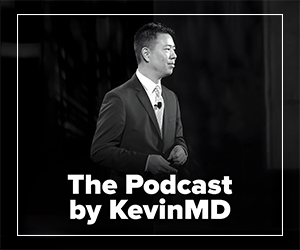Subscribe to The Podcast by KevinMD. Watch on YouTube. Catch up on old episodes!
General surgeon Arthur Williams discusses his article “A surgeon’s battle with ketamine-induced hallucinations.” He shares an account from his novel of an experience needing a pacemaker for a “janky heart” prone to atrial fibrillation and bradycardia (sick sinus node), complicated by a low ejection fraction. Arthur vividly describes the anxiety and vulnerability of being a surgeon on the patient side of the gown, his candid and sometimes critical inner thoughts during interactions with the nursing staff and anesthesiologist, and the specific fear associated with the invasive procedure. He recounts the anesthesiologist’s decision to use ketamine due to its less cardiodepressive effects, despite warning of potential “weird dreams.” Arthur then details the profound and disorienting visual hallucinations—kaleidoscopes of fire, burning apparitions, and a sense of crossing the River Styx—that occurred after the ketamine was administered, offering a raw look at the potential side effects of anesthesia from a physician’s unique vantage point.
Our presenting sponsor is Microsoft Dragon Copilot.
Microsoft Dragon Copilot, your AI assistant for clinical workflow, is transforming how clinicians work. Now you can streamline and customize documentation, surface information right at the point of care, and automate tasks with just a click.
Part of Microsoft Cloud for Healthcare, Dragon Copilot offers an extensible AI workspace and a single, integrated platform to help unlock new levels of efficiency. Plus, it’s backed by a proven track record and decades of clinical expertise—and it’s built on a foundation of trust.
It’s time to ease your administrative burdens and stay focused on what matters most with Dragon Copilot, your AI assistant for clinical workflow.
VISIT SPONSOR → https://aka.ms/kevinmd
SUBSCRIBE TO THE PODCAST → https://www.kevinmd.com/podcast
RECOMMENDED BY KEVINMD → https://www.kevinmd.com/recommended
Transcript
Kevin Pho: Hi, and welcome to the show. Subscribe at KevinMD.com/podcast. Today we welcome back Arthur Williams. He’s a surgeon and author. And today’s KevinMD article is an excerpt from his novel, Crooked Ketamine. The excerpt’s titled “A surgeon’s battle with ketamine induced hallucinations.” Arthur, welcome back to the show.
Arthur Williams: Hi. Thank you very much, Kevin. I appreciate the time.
Kevin Pho: All right. I think I last had Arthur on about three to four years ago, and he’s a surgeon and writer of novels. For those who didn’t get a chance to listen to our previous episodes, just tell us a little bit about yourself and how you got into writing in the first place.
Arthur Williams: I’m a surgeon in Cincinnati, Ohio. I’ve been in practice for over 20 years and over the past, starting back six or so years ago, I’ve had some health issues that have forced me to slow down. I’ve actually retired from practice about 18 months ago.
During this time I’ve always been interested in writing and telling stories. Being a surgeon or being a physician, and especially a surgeon, you come across some interesting stories. Surgery and medicine are fairly stressful. This is a good outlet to reduce some of that stress and it’s cheaper than a therapist. That’s my interest in writing. I come from a family of writers. My mother was an English teacher as well, so perhaps there’s some genetic component there.
Kevin Pho: All right. Your latest novel is called Crooked Ketamine. There’s an excerpt from that novel on KevinMD. Tell us about this particular story.
Arthur Williams: It’s semi-autobiographical. To back up a little bit, I’ll fill you in on some of my health issues. About six or so years ago, I was working in the backyard and developed a racing heartbeat. I thought I was just working too hard, but it didn’t go away. I went to the emergency room. I was in AFib with RVR and did not feel very well. This all progressed to needing a pacemaker; I was in RVR and also had sick sinus syndrome. When I wasn’t in AFib, I had a very slow heart rate, so the electrophysiologist recommended I get a pacemaker.
The pacemaker led to more AFib, which led to a procedure to try to ablate the AFib. Then that led to needing a defibrillator. I’ve had four or five procedures and each time they gave me ketamine as an anesthetic. Each time I had vivid hallucinations. Ketamine is a dissociative anesthetic and you get these wild out-of-body experiences. The first one was I was on a pirate ship, and it was burning. It was just bizarre. I don’t know where that came from, but it gave me an idea for a story to tell about a physician, a surgeon who’s having problems with his heart and he can’t figure out why.
The autobiographical part of the book is I was having these experiences and I didn’t know why. I was healthy: I wasn’t overweight, never smoked, didn’t really drink, and was having these health issues just out of the blue. That led me on a path to try and figure out what was going on.
In moments of introspection and trying to figure this out, I harkened back to college where I studied human evolution, and then medical school. In college, with evolution, you learned how evolution works to perfect the human species. Then you get into medical school and you realize we’re not perfect by a long shot. We have traits that seem to do us in. The response to sepsis seemed very curious to me from an evolutionary perspective, our congestive heart failure.
The body seems to be working against itself. The blood pressure goes up, blood vessels constrict when the heart fails, and that just sends you into a deep spiral. There are a host of things like this. As a surgeon who deals with gallbladders all the time, appendix, appendectomies—these organs seem to be working against us.
That led me to think about some of the anxieties around being an academic surgeon, and that anxiety: anxieties about life, anxieties about career, and anxieties about perhaps how I deal with people, deal with different sexes, different races, different religions. We all have knee-jerk reactions to these things. It got me down the path of thinking that not only do we have these double-crossing traits—that seem to get us later in life as a human species—we have these double-crossing traits that, when we were a hundred thousand, 200,000 years ago, these xenophobic traits were advantageous to the tribe or to the species. And now that we’ve evolved—hopefully we’ve evolved—these knee-jerk xenophobic or racist traits are coming back to bite us.
That’s some of the themes of the book. It’s called Crooked Ketamine, and it’s spelled with a K; that gives you some foreshadowing that things aren’t as they appear. There are a lot of plot twists throughout the book, and that’s one aspect of the crookedness in the title. Then there’s the human body’s adaptations that we talked about that are double-crossing us. Then there are cultural double crosses. There’s a deep and winding path that seems to be crooked throughout the tale.
Kevin Pho: Let’s get back to when you were given ketamine and you had these out-of-body experiences. You dreamt or thought that you were on a pirate ship, for instance. How long did these hallucinations last and did it give you insight in terms of writing about these into one of the characters in your book?
Arthur Williams: The self-experience that I had with ketamine didn’t seem to last very long: five, ten minutes, the length of the procedure probably, at most. But in the book I stretched that out; I used a little artistic license.
The very initial paragraph of the book theorizes that certain people are more susceptible to ketamine than others. In the book, the protagonist has vivid, vivid, vivid dreams on ketamine that seem to go on even longer than what would be expected for the procedure. The ketamine, my experience, gave me the idea and then I ran with it in the novel.
Kevin Pho: In terms of your experiences in this book and giving you some of the ideas about some of the crookedness in terms of our health care system, how much did your experience as an academic surgeon for decades inform the plot of your novel?
Arthur Williams: That’s a good question. In residency especially, there are a lot of exciting times. When you’re on the trauma service every day, you’re encountering these acute life and death situations. I worked after residency; I worked with the VA. There wasn’t quite that acuteness, but there certainly were memorable patients and memorable stories.
Those play out through the book as well. You have to write what you know, at least that’s my experience, and I draw heavily on those patients that I remember. Some of the people that I’ve worked with show up in the book in different ways. It’s not meant to be fully biographical; it’s a work of fiction, but certainly those people—their characteristics show up in the writing. It’s unavoidable to tell a good story.
Kevin Pho: Now, ketamine is also used outside of the operating room. I know that there are a variety of psychiatric conditions that are being treated with ketamine. How often do hallucinations happen when one undergoes ketamine treatment?
Arthur Williams: That’s a good question. You’re asking the plumber an electrical question. I don’t know all the ins and outs of ketamine. The only real experience I had with administering the drug was when we were on the burn unit, the pediatric burn unit. They would give ketamine during dressing changes and interventions with them, and it’s a bizarre drug.
It works very well both psychiatrically and anesthetically, but for the clinician, it can be unsettling because the patient doesn’t seem to be asleep. The patient can be mumbling or talking during and be completely oblivious to what’s going on, but it’s apparently a dissociative anesthetic. And I think a fair amount of people have the same experience I have where they have a vivid out-of-body experience associated with it. But you’d have to ask an anesthesiologist maybe, or a psychiatrist who deals with it. They could give you a better answer than I could.
Kevin Pho: We’re talking to Arthur Williams. He’s a surgeon and author. We’re talking about an excerpt from his book, Crooked Ketamine. And that excerpt is “A surgeon’s battle with ketamine induced hallucinations.” Arthur, what are some take-home messages you want to leave with the KevinMD audience?
Arthur Williams: One of the take-home messages I never really paid attention to was dealing with the stressors in work—surgeons, but physicians, we have a very stressful job. If I had a heart rate monitor on during a gallbladder procedure, which those were my least favorite operations, you’d have typically a junior resident that you’re operating with.
With the more minimally invasive approaches to surgery, as a guiding surgeon, you lose some of the guiding instruction. The trainee is doing the operation; you’re not really able to guide them through it. You can talk them through it, obviously, but they’re doing most of the work, whereas if you’re doing an open procedure, you’ve got your hands in there and you’re guiding them as well.
Losing that control is very stressful. As surgeons, we’re a macho breed for the most part. We don’t like to admit that that might be affecting us. I know I ignored it my whole career. If I were a chairman of a department somewhere, I’d have a mandatory wellness program or a meditation session for all the people to be attuned with that; it might have avoided some of the heartache, literal heartache, I had later in my career. That’s the main takeaway from this book, in the message that’s in there.
Kevin Pho: Thank you so much for sharing your perspective and insight and thanks again for coming back on the show.
Arthur Williams: You’re very welcome. Thank you, Kevin.



























